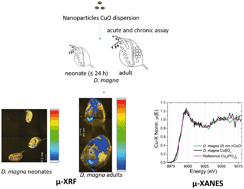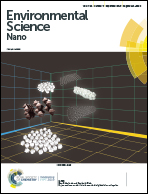Toxicity, bioaccumulation and biotransformation of Cu oxide nanoparticles in Daphnia magna†
Abstract
This study investigated the toxicity, bioaccumulation and biotransformation of copper oxide nanoparticles (nCuO) and CuSO4 in Daphnia magna. We performed acute and chronic assays, and analyzed the organisms by μ-XRF and μ-XANES. In acute assays 25 nm nCuO (LC50 0.05 ± 0.011 mg Cu per L) and CuSO4 (LC50 0.16 ± 0.015 mg Cu per L) were most toxic, while 40 nm and 80 nm nCuO had similar toxicity (LC50 2.34 ± 0.479 and 2.26 ± 0.246 mg Cu per L, respectively). In chronic assays, CuSO4 (EC50 1.7 × 10−4 ± 1.0 × 10−4 mg Cu per L) was most toxic followed by 25 nm nCuO (EC50 1.8 × 10−3 ± 8.0 × 10−4 mg Cu per L), while 40 and 80 nm nCuO were least toxic (EC50 2.10 ± 0.669 and 1.95 ± 0.568 mg Cu per L, respectively). μ-XRF showed that Cu was accumulated in the intestine and appendages of the daphnids. μ-XANES showed that 25 nm nCuO and CuSO4 were biotransformed into Cu3(PO4)2 (acute assays), whereas 40 and 80 nm nCuO remained as CuO (chronic assays). The higher toxicity exhibited by CuSO4 and 25 nm nCuO can be explained from their higher chemical reactivity (probed by catalytic decomposition of H2O2 and μ-XANES) compared to 40 and 80 nm nCuO.



 Please wait while we load your content...
Please wait while we load your content...